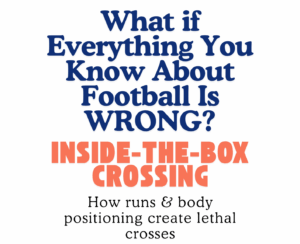
Inside the Box Crossing
A week ago, we talked about crossing situations and how crosses from more interior spaces tend to be more effective.
But how do we reach that situation? How do we manage to receive the ball inside the box in order to deliver a cross (or pass) with a higher probability of success?
As a team, we often set goals to reach certain areas of the field or to execute specific passes. We can do this in an open way, giving the player clear objectives while allowing them to find their own solutions, or in a closed way, by defining specific passes to create patterns. In this case, our goal as coaches is to work on receiving the ball inside the box in order to deliver a cross with greater chances of success.
The reflection begins with the body position of the player expected to cross. This player’s movement depends on the pass received, but our ultimate objective is for them to receive the ball with a time and space advantage that allows them to execute the cross. If we receive a pass from the inside out, the natural momentum of the run helps us reach the ball in an ideal position.
A classic example:
A midfielder passes to a winger who gets behind the fullback. These players are usually close, and the key difficulty lies in the sprint between the winger and the fullback.
Another situation:
A long pass from a midfielder to the opposite side so a winger or another midfielder can receive behind the fullback or center back. We’re talking about the gap between these defenders, often left open. The run is frontal and typically results in:
- A quick cross, or
- A direct shot (if the ball arrives more centrally).
The ball usually arrives in the air, making it harder to control, but the body shape is favorable. A diagonal run is more effective than a frontal one, although both work. Defenders lose sight of the attacker and react late.
The problem appears when the pass comes from the outside:
- A forward runs horizontally into the optimal zone, but their momentum carries them wide after receiving the ball, forcing them to turn before crossing (a loss of time).
- A midfielder makes a frontal run between the center back and fullback (effective, but defenders can track them since the ball is nearby).
So, what can we do to optimize this movement?
The player who is supposed to receive should start from a position that forces the center back to step forward to defend. If the center back doesn’t defend, the player can turn or pass to the winger making the run. If the center back does step up, that’s the moment to make the run behind their back. This movement should be continuous, starting close to the center back we want to draw out. That way, we avoid receiving the ball with a well-positioned defender who only needs to push us toward the sideline.
Looking to sharpen your attacking play with real, game-tested ideas? Follow @alexdoradoteam on Instagram for practical drills, tactical insights, and daily content straight from the pitch.
